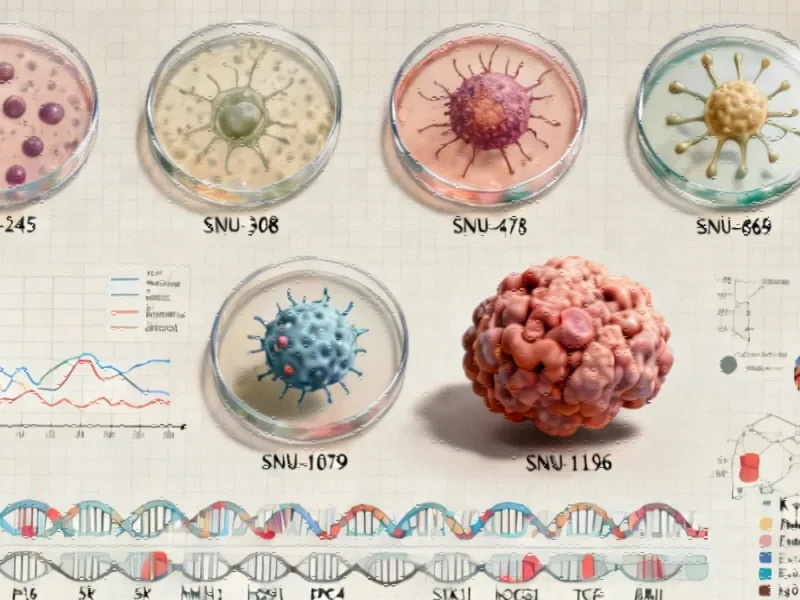Advancing Biliary Tract Cancer Research Through Novel Cell Lines
Researchers have successfully established and characterized six new human biliary tract cancer cell lines, marking a significant advancement in the study of this aggressive malignancy. The newly developed cell lines—designated SNU-245, SNU-308, SNU-478, SNU-869, SNU-1079, and SNU-1196—originated from Korean patients with various forms of biliary tract cancer, including extrahepatic bile duct cancer, intrahepatic bile duct cancer, gallbladder adenocarcinoma, and ampulla of Vater cancer.
The establishment of these cell lines addresses a critical gap in biliary tract cancer research, as permanently growing cell lines for this cancer type remain exceptionally rare. With only 13 such cell lines previously reported in scientific literature, this addition substantially expands the research community’s toolkit for investigating tumor biology and developing new therapeutic approaches.
Comprehensive Genetic and Molecular Characterization
Scientists conducted extensive analysis of these cell lines, examining multiple genetic alterations involving key cancer-related genes including K-ras, p15, p16, p53, hMLH1, hMSH2, DPC4, STK11, E-cadherin, hOGG1, and TGF-βRII. The research team employed sophisticated techniques such as PCR-SSCP for mutation screening and DNA sequencing to identify abnormal genetic patterns.
Particular attention was given to the methylation status of the E-cadherin gene promoter region, investigated through 5-aza-2′-deoxycytidine treatment and methylation-specific polymerase chain reaction following sodium bisulphite treatment. This comprehensive approach allowed researchers to compare genetic alterations between the established tumor cell lines and their corresponding tumor tissues, providing valuable insights into the consistency of genetic markers across different sample types.
These research developments in cancer cell line establishment represent significant progress in understanding biliary tract malignancies, which have historically shown poor patient prognosis despite advances in diagnostic and therapeutic techniques.
Methodological Innovations and Validation
The cell lines were established from pathologically confirmed primary biliary tract cancer samples using meticulous tissue processing techniques. Tumor tissues were finely minced and dissociated into small aggregates before being seeded into culture flasks. Initial cultures utilized ACL-4 medium supplemented with 5% heat-inactivated fetal bovine serum, with subsequent maintenance in RPMI 1640 medium containing 10% serum.
Researchers implemented rigorous quality control measures, including DNA profile analysis using highly polymorphic microsatellite markers to authenticate each cell line. The team also documented in vivo and in vitro growth characteristics, population doubling times, cell viability, and morphological features through daily phase-contrast microscopy observations.
This methodological rigor ensures the reliability of these new research tools for future studies investigating biliary tract cancer biology and potential therapeutic interventions.
Broader Implications for Cancer Research
The establishment of these six new cell lines comes at a time when significant investments are being made in biomedical research infrastructure. As the scientific community continues to develop more sophisticated research tools, these cell lines will enable deeper investigation into the molecular mechanisms driving biliary tract cancer progression.
Meanwhile, the broader research landscape is being transformed by artificial intelligence tools that can analyze complex genetic data more efficiently. The comprehensive genetic characterization of these cell lines provides valuable datasets that could benefit from such computational approaches.
The timing of this research aligns with technology trends emphasizing data-driven medical research. As computational power increases and analytical methods become more sophisticated, well-characterized biological models like these cell lines become increasingly valuable for validating computational predictions and testing novel therapeutic hypotheses.
Future Research Directions and Applications
These newly established cell lines open numerous possibilities for future research, including:
- Drug screening platforms for testing potential therapeutic compounds
- Molecular pathway analysis to identify new drug targets
- Personalized medicine approaches by matching genetic profiles with treatment responses
- Combination therapy studies that could improve treatment efficacy
The research community’s ability to share and collaborate on well-characterized biological models reflects the kind of collaborative innovation seen across multiple industries. As these cell lines become available to researchers worldwide, they will likely accelerate progress in understanding and treating this challenging form of cancer.
The establishment of these six biliary tract cancer cell lines represents not just an addition to laboratory tools but a potential turning point in how researchers approach this complex disease, offering new hope for improved patient outcomes through better understanding of tumor biology and more targeted therapeutic development.
This article aggregates information from publicly available sources. All trademarks and copyrights belong to their respective owners.
Note: Featured image is for illustrative purposes only and does not represent any specific product, service, or entity mentioned in this article.
